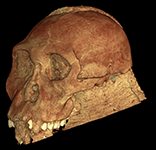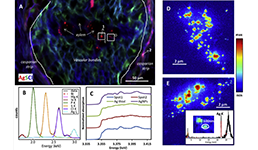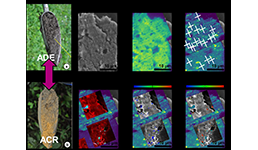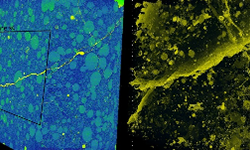- Home
- Users & Science
- Find a beamline
- Matter at extremes
- Geobridge - Geoscience at the ESRF
- Research topics
- Surface and Atmosphere
Surface and Atmosphere
Earth's surface holds the ancient history of our continents but also more recently the testimony of life developments or the emergence of humanity. It also keeps fossil evidence of our past climate and its evolution. The present chemical evolution of the atmosphere, especially in terms of CO2 concentration change, is a pressing problem that ESRF wishes to help solve. The chemical evolution of the atmosphere especially in terms of CO2 concentration changes and its effect on the climate is presently investigated at the ESRF through studies on the ingassing of volatiles (carbon, water) and their storage in the deep Earth’s mantle.
Recent research topics
|
|
Vincent Beyrand (Visiting Scientist at BM18) and Paul Tafforeau (Scientist at BM18) are studying our origins and the anthropological evolution of human lineage, mainly through the scope of dental dental development and skull anatomy. |
|
|
Hiram Castillo (Scientist at ID21) applies synchrotron µXRF/µXANES to study the distribution and biochemical modification of trace elements and nanomaterials in the environment. In particular, he is interested in the fate and transport of nanomaterials and potentially toxic elements in agricultural systems. Since plants are part of the first trophic level, they are a main route of entrance of toxic elements in the food chain. These toxic elements and nanomaterials are environmental stressors at the tissue and cellular level, disrupting important biochemical functions in living organisms. The specific localization and chemical form of these stressors at the tissue and subcellular level are the main objects of my research. |
|
|
Luis Carlos Colocho Hurtarte (Post-Doc at ID21) is investigating the coupled carbon and phosphore cycles in soils of different terrestrial natural and agro-ecosystems, ultimately aiming to provide technological solutions for the sustainable use of phosphore. For this, he uses (micro)spectroscopy to resolve the microspatial interactions of biotic systems with soil minerals and phosphorus. |
|
|
Benoit Cordonnier (Visiting Scientist at ID19) and co-workers are investigating the CO2 storage mechanisms in the oceanic crust, a natural CO2 sink. Serpentine or basalts are prime candidates, their permeability and potential for CO2 storage is carefully evaluated using tomography imaging at ESRF. This research aims to provide rapid solutions to reduce global warming. |
|
|
Kathleen Dollman (Post-Doc at BM18), Vincent Beyrand (Visiting Scientist at BM18), P. Tafforeau (Scientist BM18) Paleontology is a domain of strong interests at ESRF. Palaeontology is the study of the evolution of life on earth through fossils and their living descendants. The ESRF allows us to study fossils in a high degree of detail, which allows us to test new hypotheses about palaeoenvironments, systematics, phylogenetics palaeoecology and evolutionary biology. |








